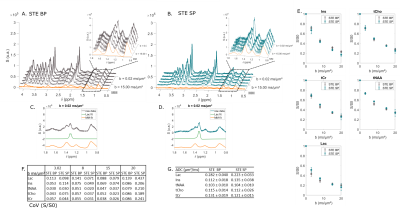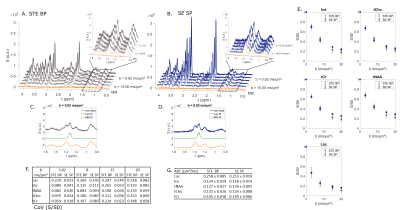Eloïse Mougel1, Sophie Malaquin1, Melissa Vincent1, and Julien Valette1
1Université Paris-Saclay, Commissariat à l'Energie Atomique et aux Energies Alternatives (CEA), Centre National de la Recherche Scientifique (CNRS), Molecular Imaging Research Center (MIRCen), Laboratoire des Maladies Neurodégénératives, Fontenay aux Roses, France
1Université Paris-Saclay, Commissariat à l'Energie Atomique et aux Energies Alternatives (CEA), Centre National de la Recherche Scientifique (CNRS), Molecular Imaging Research Center (MIRCen), Laboratoire des Maladies Neurodégénératives, Fontenay aux Roses, France
Diffusion-weighted
MR spectroscopy may allow investigating lactate cellular compartmentation in
the brain. We investigate the ability of selective pulse to suppress
J-modulation and thus provide more robust information on lactate diffusion.

Figure 2: Stimulated
echo spectra comparison for different diffusion-weighting values. A-B) spectra
acquired during the same experimental session, respectively with STE using broad
pulse (BP) and STE using selective pulse
(SP). C-D) Lactate peaks as extracted with LCModel. E) Average S/S0 ratio over
four blocks of 32 averages as a function of diffusion weighting (b). F) CoV of S/S0
for each b-value and each metabolites. G) Calculated ADC with STE BP data and
STE SP data.

Figure 4: Stimulated
echo using BP versus spin echo using SP. A-B) spectra acquired respectively
with STE using BP and SE using SP. C-D) Lactate peaks as extracted with LCModel.
E) Average S/S(b=0) = S/S0 ratio over
four blocks of 32 averages as a function of diffusion weighting (b). F) CoV of
S/S0 for each b-value and each metabolites. G) Calculated ADC with STE BP data
and SE SP data.